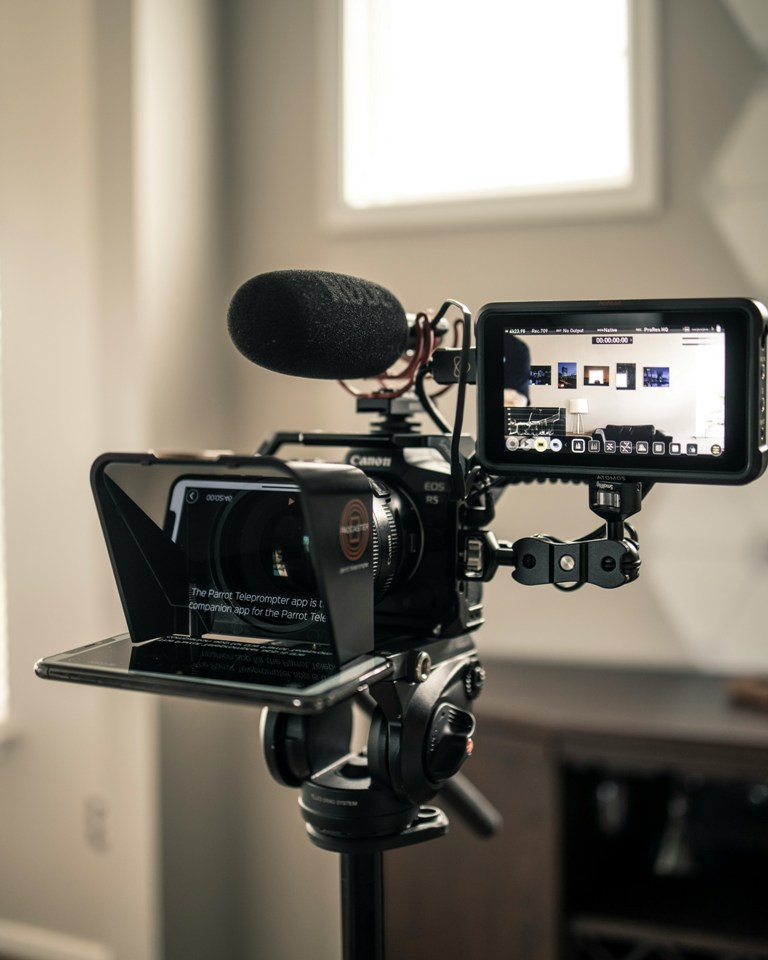It’s common to struggle while reading from a teleprompter. But mastering the art of teleprompter reading is not impossible. The key lies in striking a balance between sounding natural and maintaining eye contact with your audience. As experienced vocal coaches, here are our tips on how you, too, can excel at reading from the teleprompter and deliver flawless presentations!
Mastering the Art of Teleprompter Reading
Teleprompters have become an indispensable tool for public speakers and broadcasters, enabling them to deliver speeches and presentations with confidence and precision. Effectively utilizing a teleprompter requires a unique set of skills and techniques. 
Getting Started with Teleprompter Reading
Effective communication using a teleprompter involves understanding the basics, selecting the right type of device, and learning the setup. Along with this, understanding how to trust in utilizing a teleprompter also helps with ensuring a smooth delivery each time.
- A teleprompter is a visual aid that displays a script for you to read while looking directly at the camera lens, maintaining an impression of eye contact with the audience. This is beneficial for delivering speeches, news, or presentations without memorizing lines.
- To set up your teleprompter, place it at a comfortable height and distance, where you can read the text without straining. Make sure the camera and teleprompter glass are aligned for direct eye contact. Use large, clear fonts and break the script into short, manageable sections.
- While operating, adjust the scroll speed to match your natural pacing. Use a remote control to start, stop, and navigate the script as needed. Practice reading out loud to get comfortable with the flow of the script on the device.
There is a great variety of teleprompters and among the best-known are:
- Presidential: These teleprompters consist of a clear screen that reflects the text, positioned near the camera lens, giving you the ability to address a live audience.
- Camera-mounted: Attached directly to the camera.
- Freestanding: A versatile choice, they stand on their own and can be used with different cameras and settings.
- Tablet-based: Using a tablet device, they are a cost-effective and portable teleprompter setup.
Preparation and Scripting
Mastering reading on a teleprompter begins with making necessary preparations for a teleprompter presentation and meticulous scripting to guarantee a smooth presentation. This phase is vital to delivering your message with confidence and ease.
- Crafting your script: Your script is the foundation of your teleprompter reading. Use short sentences and paragraphs to facilitate easy reading and natural pauses. Keep in mind that the script should be written as you speak.
- Familiarizing yourself with the script: Once your script is ready, take the time to familiarize yourself with it. A deep understanding of the content allows you to read from the teleprompter seamlessly.
- Rehearsing: The key to a confident reading on a teleprompter is rehearsal. Practice reading the script out loud several times to get comfortable with the flow of words.
Mastering Delivery and Performance
To engage your audience during reading on a teleprompter, it’s vital to master what you say and how you say it. Channeling the right voice, tone, and body language while maintaining eye contact can transform your delivery from monotone reading to a dynamic performance.

- Your voice is your instrument. Project confidence and clarity by modulating your voice to match the content’s pacing and emotion. Maintain a steady flow that feels natural; avoid rushing through words or speaking too slowly.
- The tone of your delivery should align with the message you’re conveying. A serious topic demands a more sober tone, while lighter material can be delivered with a touch of warmth or humor. Remember, the audience doesn’t just hear your words; they feel them.
- Gestures and body language are potent tools for emphasizing your message. Use your hands to reinforce key points yet be mindful not to overdo it.
- When reading from a teleprompter, maintaining eye contact with the camera lens bridges the gap between you and your audience. Minimize eye movement by placing the teleprompter close to the camera.
 Practical Teleprompter Techniques
Practical Teleprompter Techniques
To use a teleprompter effectively, you need to master certain teleprompter techniques that guarantee clarity and engagement in your delivery. These range from controlling the pace to expressing the right emotions through your voice.
- Pacing and rhythm: Pacing is imperative to keep your audience engaged. To manage pacing, first practice with your prompter software or opting for the suitable teleprompter app to find a scrolling speed that matches your natural speaking rate.
- Pronunciation and articulation: Every word should be pronounced correctly to maintain clarity. If you stumble, remain calm, and carry on; your operator can help you by adjusting the text speed. Practicing tongue twisters helps to strengthen diction and articulation skills.
- Intonation and vocal variety: Your personality shines through your intonation and vocal variety. By varying your pitch and volume, you can emphasize key points in your presentation. Consider working with a voice coach if you aim to enhance your on-camera presentation skills for broadcasting.
Related Questions
Is It Okay to Modify the Script on the Teleprompter?
Yes, it’s acceptable to modify the script on the teleprompter under certain circumstances. Firstly, it allows for real-time adjustments to better cater to the audience’s reactions or address unforeseen situations. Secondly, script modifications can enhance spontaneity and authenticity, making the delivery more engaging and relatable.
Should You Practice With the Complete Hardware Setup?
Yes, practicing with the complete hardware setup is imperative for optimal teleprompter performance. It allows you to become familiar with the physical aspects of it, such as the positioning, distance, and angle. It enables you to identify and address any technical issues or challenges that may arise during speech.
How Often Should You Rehearse With a Teleprompter?
Rehearsing with a teleprompter should be a regular and consistent practice to maximize your performance. It provides opportunities for self-assessment and improvement, refining your pacing, intonation, and non-verbal communication, which ensures a polished and confident teleprompter presentation.
Conclusion
Mastering reading from a teleprompter essentially boils down to the harmony between you and the technology. Your ability to engage with the teleprompter as if it’s a friend rather than a mechanical device makes the difference. Discover its ins and outs, practice with it, and watch your relationship naturally sync.







